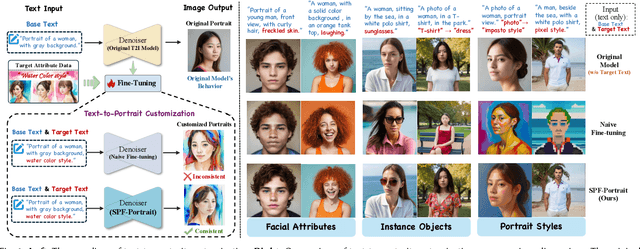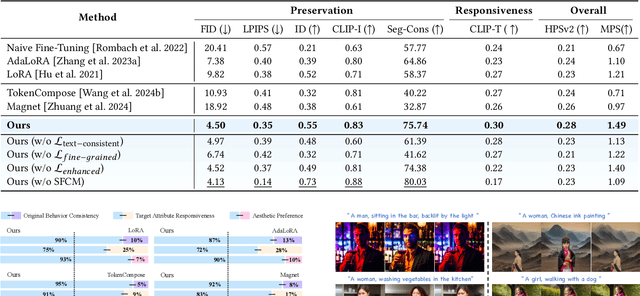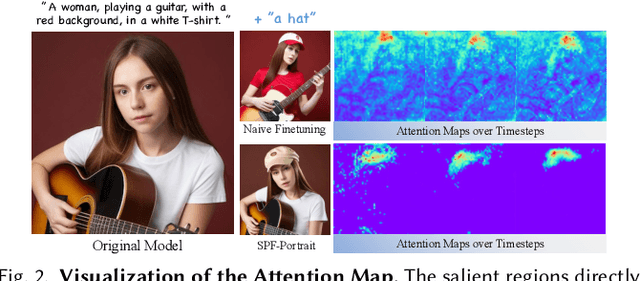Weicheng Xie
Distribution-Specific Learning for Joint Salient and Camouflaged Object Detection
Aug 08, 2025Abstract:Salient object detection (SOD) and camouflaged object detection (COD) are two closely related but distinct computer vision tasks. Although both are class-agnostic segmentation tasks that map from RGB space to binary space, the former aims to identify the most salient objects in the image, while the latter focuses on detecting perfectly camouflaged objects that blend into the background in the image. These two tasks exhibit strong contradictory attributes. Previous works have mostly believed that joint learning of these two tasks would confuse the network, reducing its performance on both tasks. However, here we present an opposite perspective: with the correct approach to learning, the network can simultaneously possess the capability to find both salient and camouflaged objects, allowing both tasks to benefit from joint learning. We propose SCJoint, a joint learning scheme for SOD and COD tasks, assuming that the decoding processes of SOD and COD have different distribution characteristics. The key to our method is to learn the respective means and variances of the decoding processes for both tasks by inserting a minimal amount of task-specific learnable parameters within a fully shared network structure, thereby decoupling the contradictory attributes of the two tasks at a minimal cost. Furthermore, we propose a saliency-based sampling strategy (SBSS) to sample the training set of the SOD task to balance the training set sizes of the two tasks. In addition, SBSS improves the training set quality and shortens the training time. Based on the proposed SCJoint and SBSS, we train a powerful generalist network, named JoNet, which has the ability to simultaneously capture both ``salient" and ``camouflaged". Extensive experiments demonstrate the competitive performance and effectiveness of our proposed method. The code is available at https://github.com/linuxsino/JoNet.
Oral Imaging for Malocclusion Issues Assessments: OMNI Dataset, Deep Learning Baselines and Benchmarking
May 21, 2025Abstract:Malocclusion is a major challenge in orthodontics, and its complex presentation and diverse clinical manifestations make accurate localization and diagnosis particularly important. Currently, one of the major shortcomings facing the field of dental image analysis is the lack of large-scale, accurately labeled datasets dedicated to malocclusion issues, which limits the development of automated diagnostics in the field of dentistry and leads to a lack of diagnostic accuracy and efficiency in clinical practice. Therefore, in this study, we propose the Oral and Maxillofacial Natural Images (OMNI) dataset, a novel and comprehensive dental image dataset aimed at advancing the study of analyzing dental images for issues of malocclusion. Specifically, the dataset contains 4166 multi-view images with 384 participants in data collection and annotated by professional dentists. In addition, we performed a comprehensive validation of the created OMNI dataset, including three CNN-based methods, two Transformer-based methods, and one GNN-based method, and conducted automated diagnostic experiments for malocclusion issues. The experimental results show that the OMNI dataset can facilitate the automated diagnosis research of malocclusion issues and provide a new benchmark for the research in this field. Our OMNI dataset and baseline code are publicly available at https://github.com/RoundFaceJ/OMNI.
Denoising and Alignment: Rethinking Domain Generalization for Multimodal Face Anti-Spoofing
May 14, 2025Abstract:Face Anti-Spoofing (FAS) is essential for the security of facial recognition systems in diverse scenarios such as payment processing and surveillance. Current multimodal FAS methods often struggle with effective generalization, mainly due to modality-specific biases and domain shifts. To address these challenges, we introduce the \textbf{M}ulti\textbf{m}odal \textbf{D}enoising and \textbf{A}lignment (\textbf{MMDA}) framework. By leveraging the zero-shot generalization capability of CLIP, the MMDA framework effectively suppresses noise in multimodal data through denoising and alignment mechanisms, thereby significantly enhancing the generalization performance of cross-modal alignment. The \textbf{M}odality-\textbf{D}omain Joint \textbf{D}ifferential \textbf{A}ttention (\textbf{MD2A}) module in MMDA concurrently mitigates the impacts of domain and modality noise by refining the attention mechanism based on extracted common noise features. Furthermore, the \textbf{R}epresentation \textbf{S}pace \textbf{S}oft (\textbf{RS2}) Alignment strategy utilizes the pre-trained CLIP model to align multi-domain multimodal data into a generalized representation space in a flexible manner, preserving intricate representations and enhancing the model's adaptability to various unseen conditions. We also design a \textbf{U}-shaped \textbf{D}ual \textbf{S}pace \textbf{A}daptation (\textbf{U-DSA}) module to enhance the adaptability of representations while maintaining generalization performance. These improvements not only enhance the framework's generalization capabilities but also boost its ability to represent complex representations. Our experimental results on four benchmark datasets under different evaluation protocols demonstrate that the MMDA framework outperforms existing state-of-the-art methods in terms of cross-domain generalization and multimodal detection accuracy. The code will be released soon.
PhysLLM: Harnessing Large Language Models for Cross-Modal Remote Physiological Sensing
May 06, 2025Abstract:Remote photoplethysmography (rPPG) enables non-contact physiological measurement but remains highly susceptible to illumination changes, motion artifacts, and limited temporal modeling. Large Language Models (LLMs) excel at capturing long-range dependencies, offering a potential solution but struggle with the continuous, noise-sensitive nature of rPPG signals due to their text-centric design. To bridge this gap, we introduce PhysLLM, a collaborative optimization framework that synergizes LLMs with domain-specific rPPG components. Specifically, the Text Prototype Guidance (TPG) strategy is proposed to establish cross-modal alignment by projecting hemodynamic features into LLM-interpretable semantic space, effectively bridging the representational gap between physiological signals and linguistic tokens. Besides, a novel Dual-Domain Stationary (DDS) Algorithm is proposed for resolving signal instability through adaptive time-frequency domain feature re-weighting. Finally, rPPG task-specific cues systematically inject physiological priors through physiological statistics, environmental contextual answering, and task description, leveraging cross-modal learning to integrate both visual and textual information, enabling dynamic adaptation to challenging scenarios like variable illumination and subject movements. Evaluation on four benchmark datasets, PhysLLM achieves state-of-the-art accuracy and robustness, demonstrating superior generalization across lighting variations and motion scenarios.
SPF-Portrait: Towards Pure Portrait Customization with Semantic Pollution-Free Fine-tuning
Apr 01, 2025



Abstract:While fine-tuning pre-trained Text-to-Image (T2I) models on portrait datasets enables attribute customization, existing methods suffer from Semantic Pollution that compromises the original model's behavior and prevents incremental learning. To address this, we propose SPF-Portrait, a pioneering work to purely understand customized semantics while eliminating semantic pollution in text-driven portrait customization. In our SPF-Portrait, we propose a dual-path pipeline that introduces the original model as a reference for the conventional fine-tuning path. Through contrastive learning, we ensure adaptation to target attributes and purposefully align other unrelated attributes with the original portrait. We introduce a novel Semantic-Aware Fine Control Map, which represents the precise response regions of the target semantics, to spatially guide the alignment process between the contrastive paths. This alignment process not only effectively preserves the performance of the original model but also avoids over-alignment. Furthermore, we propose a novel response enhancement mechanism to reinforce the performance of target attributes, while mitigating representation discrepancy inherent in direct cross-modal supervision. Extensive experiments demonstrate that SPF-Portrait achieves state-of-the-art performance.
Benchmarking Graph Representations and Graph Neural Networks for Multivariate Time Series Classification
Jan 14, 2025Abstract:Multivariate Time Series Classification (MTSC) enables the analysis if complex temporal data, and thus serves as a cornerstone in various real-world applications, ranging from healthcare to finance. Since the relationship among variables in MTS usually contain crucial cues, a large number of graph-based MTSC approaches have been proposed, as the graph topology and edges can explicitly represent relationships among variables (channels), where not only various MTS graph representation learning strategies but also different Graph Neural Networks (GNNs) have been explored. Despite such progresses, there is no comprehensive study that fairly benchmarks and investigates the performances of existing widely-used graph representation learning strategies/GNN classifiers in the application of different MTSC tasks. In this paper, we present the first benchmark which systematically investigates the effectiveness of the widely-used three node feature definition strategies, four edge feature learning strategies and five GNN architecture, resulting in 60 different variants for graph-based MTSC. These variants are developed and evaluated with a standardized data pipeline and training/validation/testing strategy on 26 widely-used suspensor MTSC datasets. Our experiments highlight that node features significantly influence MTSC performance, while the visualization of edge features illustrates why adaptive edge learning outperforms other edge feature learning methods. The code of the proposed benchmark is publicly available at \url{https://github.com/CVI-yangwn/Benchmark-GNN-for-Multivariate-Time-Series-Classification}.
DEGSTalk: Decomposed Per-Embedding Gaussian Fields for Hair-Preserving Talking Face Synthesis
Dec 28, 2024



Abstract:Accurately synthesizing talking face videos and capturing fine facial features for individuals with long hair presents a significant challenge. To tackle these challenges in existing methods, we propose a decomposed per-embedding Gaussian fields (DEGSTalk), a 3D Gaussian Splatting (3DGS)-based talking face synthesis method for generating realistic talking faces with long hairs. Our DEGSTalk employs Deformable Pre-Embedding Gaussian Fields, which dynamically adjust pre-embedding Gaussian primitives using implicit expression coefficients. This enables precise capture of dynamic facial regions and subtle expressions. Additionally, we propose a Dynamic Hair-Preserving Portrait Rendering technique to enhance the realism of long hair motions in the synthesized videos. Results show that DEGSTalk achieves improved realism and synthesis quality compared to existing approaches, particularly in handling complex facial dynamics and hair preservation. Our code will be publicly available at https://github.com/CVI-SZU/DEGSTalk.
BIG-MoE: Bypass Isolated Gating MoE for Generalized Multimodal Face Anti-Spoofing
Dec 24, 2024Abstract:In the domain of facial recognition security, multimodal Face Anti-Spoofing (FAS) is essential for countering presentation attacks. However, existing technologies encounter challenges due to modality biases and imbalances, as well as domain shifts. Our research introduces a Mixture of Experts (MoE) model to address these issues effectively. We identified three limitations in traditional MoE approaches to multimodal FAS: (1) Coarse-grained experts' inability to capture nuanced spoofing indicators; (2) Gated networks' susceptibility to input noise affecting decision-making; (3) MoE's sensitivity to prompt tokens leading to overfitting with conventional learning methods. To mitigate these, we propose the Bypass Isolated Gating MoE (BIG-MoE) framework, featuring: (1) Fine-grained experts for enhanced detection of subtle spoofing cues; (2) An isolation gating mechanism to counteract input noise; (3) A novel differential convolutional prompt bypass enriching the gating network with critical local features, thereby improving perceptual capabilities. Extensive experiments on four benchmark datasets demonstrate significant generalization performance improvement in multimodal FAS task. The code is released at https://github.com/murInJ/BIG-MoE.
CA-Edit: Causality-Aware Condition Adapter for High-Fidelity Local Facial Attribute Editing
Dec 18, 2024



Abstract:For efficient and high-fidelity local facial attribute editing, most existing editing methods either require additional fine-tuning for different editing effects or tend to affect beyond the editing regions. Alternatively, inpainting methods can edit the target image region while preserving external areas. However, current inpainting methods still suffer from the generation misalignment with facial attributes description and the loss of facial skin details. To address these challenges, (i) a novel data utilization strategy is introduced to construct datasets consisting of attribute-text-image triples from a data-driven perspective, (ii) a Causality-Aware Condition Adapter is proposed to enhance the contextual causality modeling of specific details, which encodes the skin details from the original image while preventing conflicts between these cues and textual conditions. In addition, a Skin Transition Frequency Guidance technique is introduced for the local modeling of contextual causality via sampling guidance driven by low-frequency alignment. Extensive quantitative and qualitative experiments demonstrate the effectiveness of our method in boosting both fidelity and editability for localized attribute editing. The code is available at https://github.com/connorxian/CA-Edit.
Towards Combating Frequency Simplicity-biased Learning for Domain Generalization
Oct 21, 2024Abstract:Domain generalization methods aim to learn transferable knowledge from source domains that can generalize well to unseen target domains. Recent studies show that neural networks frequently suffer from a simplicity-biased learning behavior which leads to over-reliance on specific frequency sets, namely as frequency shortcuts, instead of semantic information, resulting in poor generalization performance. Despite previous data augmentation techniques successfully enhancing generalization performances, they intend to apply more frequency shortcuts, thereby causing hallucinations of generalization improvement. In this paper, we aim to prevent such learning behavior of applying frequency shortcuts from a data-driven perspective. Given the theoretical justification of models' biased learning behavior on different spatial frequency components, which is based on the dataset frequency properties, we argue that the learning behavior on various frequency components could be manipulated by changing the dataset statistical structure in the Fourier domain. Intuitively, as frequency shortcuts are hidden in the dominant and highly dependent frequencies of dataset structure, dynamically perturbating the over-reliance frequency components could prevent the application of frequency shortcuts. To this end, we propose two effective data augmentation modules designed to collaboratively and adaptively adjust the frequency characteristic of the dataset, aiming to dynamically influence the learning behavior of the model and ultimately serving as a strategy to mitigate shortcut learning. Code is available at AdvFrequency (https://github.com/C0notSilly/AdvFrequency).
 Add to Chrome
Add to Chrome Add to Firefox
Add to Firefox Add to Edge
Add to Edge